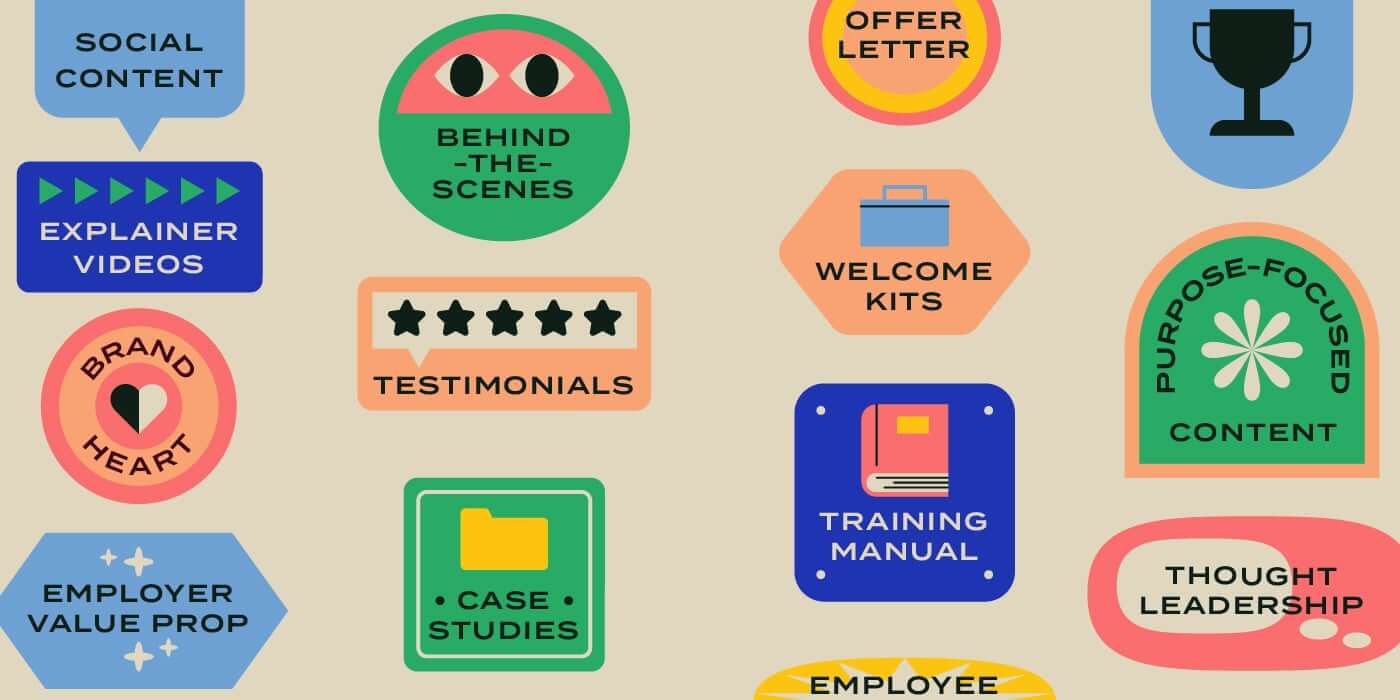Content is one of the most powerful ways to bring your employer brand to life. The stories you tell, the words you use, the photos you show—every element communicates who you are in big and small ways. The problem is too many brands rely on the same old content (the boring job description, the generic website), hoping and praying it will woo and wow potential employees. It’s no surprise their results are less than stellar. To capture people’s attention and turn potential hires into engaged employees, you need creative employer branding ideas that will help you say the right thing at the right stage of the employee journey. Not sure what that content looks like? We got you.
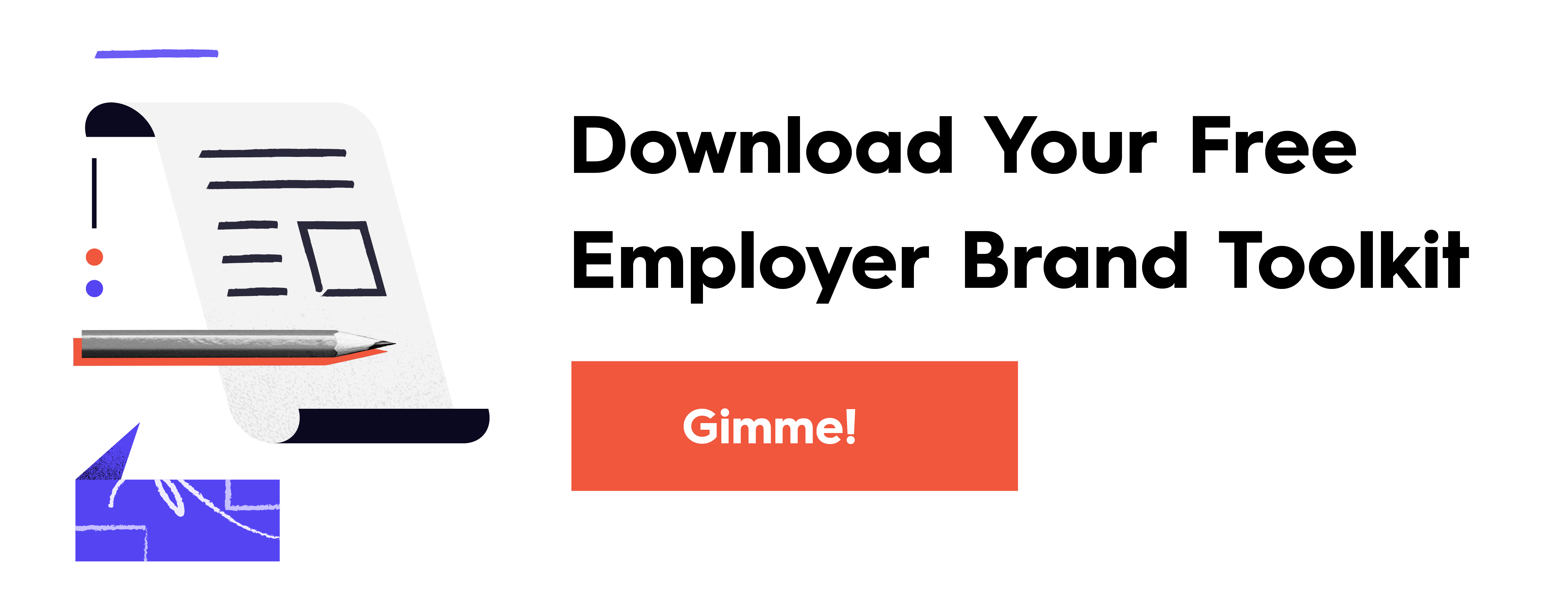
25 Employer Branding Ideas to Tell Your Story Through Content
Good employer brand content tells people what they want and need to know about your employer brand (often before they realize they want or need to know it). Luckily, you don’t necessarily have to create a ton of new content; you just need to make the most of the content you have—and fill in the gaps where you don’t have it.
In a crowded job market where it’s harder to get and keep the right people on board, telling your employer brand story is the only way to get a leg up.
To help you do that, here are 25 content ideas to tell your employer brand story, broken down by each stage of the employee journey. No matter your company size or industry, these ideas will help you reach quality applicants, keep your current employees engaged, and help you build the employer brand you want—one piece of content at a time.
Stage 1: Awareness
At this stage, you want people to notice your brand and find out about potential employment options. This type of content should capture their attention and entice them to get to know you better.
- Job description: Even the coolest job can be sabotaged by a stuffy, clinical, or super boring job description. Remember: You’re trying to generate interest and excitement, so make sure your descriptions are colorful, enticing, inclusive, and written in your brand voice.
- About Us page: This may be your Team Page, Careers Page, Culture, or People Page. Regardless, it’s a huge opportunity to bring your brand to life. Add real-life photos of your team, talk about your purpose, your passion, and what makes your company a great place to work.
- Ads: Do your ads stand out from your competition? At a glance, do they reflect your industry? Your mission? Your people? Bold, visual, eye-catching ads that speak to the right type of people are the key to finding more quality applicants.
- Social content: Facebook, Twitter, Instagram, LinkedIn—these platforms are where your employer brand can really shine. Are your people front and center? Does your personality stand out? Photos, quizzes, Q&As, playlists, or user-generated content can give people an immediate sense of your brand.
- Explainer videos: Video is a particularly effective medium, letting you communicate information quickly and show (not just tell people) who you are, what you’re about, and why your brand is great. Here are 50 inspiring explainer videos that do this well.
- Origin story: Your backstory can speak volumes about your employer brand and help people really get to know you. Were you founded by a team of intrepid hikers eager to make a healthy granola for the trails? Was your company born of a happy accident? (Ours was.) Share the story in an interesting way.
Example: Warby Parker shares the literature-centric genesis of the company name in an entertaining way.
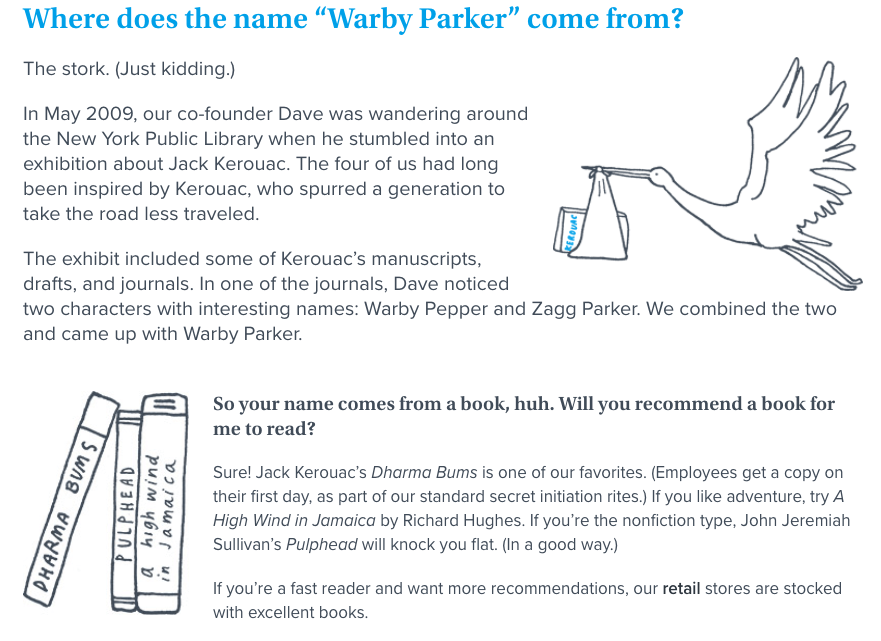
Example: The team at KIND shares what makes the company different in an engaging video that dives into the brand’s philosophy and benefits.
Stage 2: Consideration
At this stage, you want to convince people to apply, so it’s all about giving them more info than they get in a job description. Lead with your core principles, your passions, your people, and your successes.
- Brand Heart: Your Brand Heart is comprised of your purpose, vision, mission, and values. People want to work for brands they believe in, so make sure these elements are showcased in your site and content. For more inspiration, here are 10 ways other brands have done this well.
- Employer Value Proposition: Your EVP is a concise and enticing explanation of what you offer employees who work for you. Think of it as a call to arms. All job descriptions (and especially your Careers Page) should feature your EVP. If you haven’t written one or need to refresh yours, follow our guide to write a strong EVP.
- Behind-the-scenes looks: If you want to attract the best and brightest, bring them “into” the office before they apply. Show off your office space, team, events, production process, or any other peek behind the curtain to give people a real sense of your employer brand.
- Confirmation email: Job hunting is stressful enough; don’t let potential hires sit in limbo wondering if you got their email. Respond with a friendly and personality-packed confirmation email to start your relationship off on the right foot.
- Testimonials: Other people’s experiences matter. Whether it’s a client testimonial, a rave review from a site like Glassdoor, or a shoutout from LinkedIn, lend credibility to your employer brand by letting other people do the talking about you.
- Case studies: People aren’t applying to hang out with you; they’re applying to work for you. Highlight what you do and how you do it via unique case studies that showcase your team’s skills, critical thinking, and creative problem-solving.
Example: Ben and Jerry’s turned their hiring process into a colorful, informative graphic. This helps applicants know what to expect and showcases the brand’s playful side.
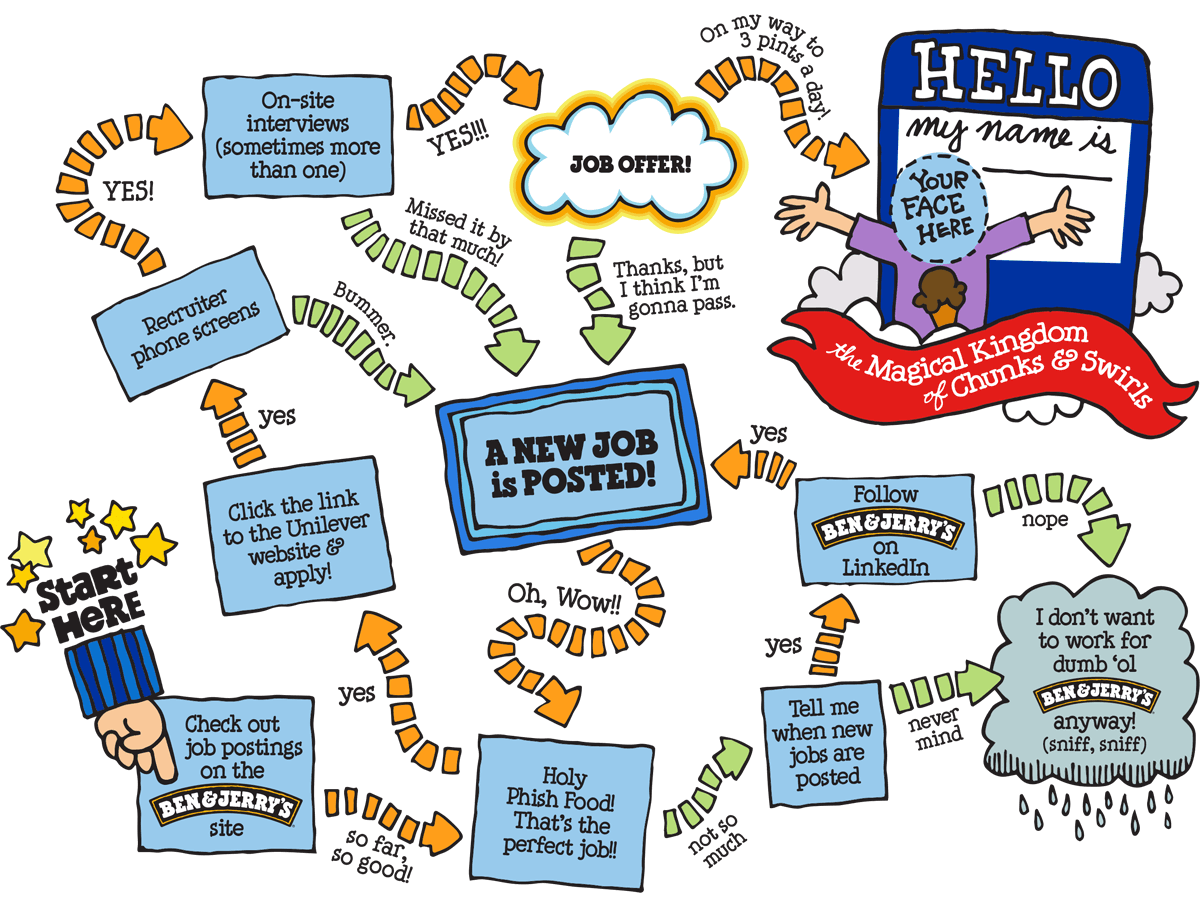
Example: Designer Eileen Fisher is dedicated to ethical manufacturing at every level. To prove that commitment, she shares her vision, strategy, and data around sustainability, revealing an impressive level of transparency that any potential employee would find inspiring.
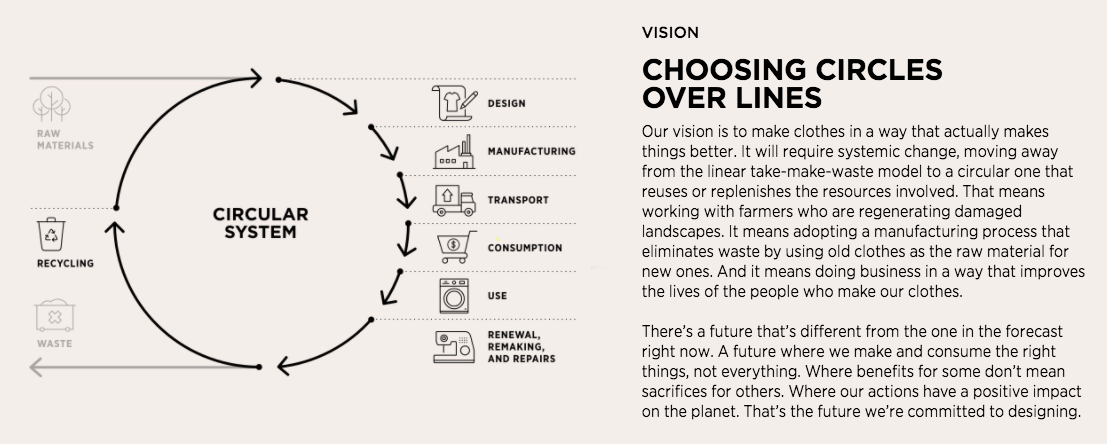
Stage 3: Decision
Once a person has gone through the application process (and decided that you’re the right fit), you need to bring them on board, help them seamlessly join the team, and make them feel welcomed.
- Offer letter: Similar to a job description, your offer letter can say a lot about your employer brand. Are you excited and hopeful about the opportunity to work together? Are you distant and impersonal? As your offer letter precedes negotiations, it’s important to make people feel valued.
- Welcome kits: The first day of work is always a little nerve wracking. Simple gestures can go a long way toward helping people feel seen, celebrated, and welcomed. Get creative with the content included in your kits. Think handwritten cards from leadership, guides to the best vending machines on site, or new hire swag (t-shirts, water bottles, personalized stationery). Note: Welcome kits are especially helpful to make remote workers feel at home.
- Training materials: Nobody wants to slog through corporate drivel. While some of the legal stuff needs to stay straightforward, there are plenty of opportunities to add some personality to your training materials.
Example: Instead of boring manuals and videos, the team at Honeygrow uses 360-degree VR video to complete training.
Example: MHS Homes sends new hires out on a virtual scavenger hunt, helping them get to know their fellow employees through the company intranet.
Stage 4: Retention
Once you have great people, you want to keep them. At this stage, you can create a variety of content to celebrate, educate, and inspire people about the work they’re doing.
- Employee spotlights: A great employer brand is made up of many interesting, unique, and intelligent people. An interview for your blog or a shoutout on social can make people feel respected and appreciated. (Again, it’s also a great way to introduce potential employees to their future coworkers.)
- Awards: Awards can be a way to acknowledge big things like hard work or creative accomplishments, but they can also be a great way to celebrate people in a fun way. Go beyond the Employee of the Month stuff here. The more personalized, the more people feel seen, so think about awards for things like Most Organized Desk, Best Coffee Maker, Proudest Dog Dad, etc.
- Surveys & feedback: Content can also be used to make people’s jobs better or help leadership make better decisions. Satisfaction surveys can help spotlight problems before they become problems, while tools like job canvases and contextual expectations can empower people to take more ownership over their work.
- Thought leadership: Your team is a wealth of information and expertise that can become unique, newsworthy content. Conduct expert interviews, ask your team for their best tips, share the biggest lessons you’ve learned from failures, etc. This type of transparency showcases your team’s knowledge and gives people an insider look at your work.
- Company newsletter: It’s easy to get caught up in the day-to-day and start to feel disconnected from your team (especially if you’re working remotely). An employee-centric newsletter offering helpful tips, reminders, or benefits updates can help people stay up to date.
- Purpose-focused content: Employees are happier and more engaged when they are united by a shared purpose. You can tap into this drive with purpose-centric content that celebrates the things your team is doing in this realm. You may recap an employee volunteer day, show off your latest pro bono project, or highlight a cause you care about. This is a great way to remind people inside your company (and, again, potential employees) why you do what you do.
- Gifts and tokens: Meaningful, thoughtful gifts are a great way to walk the walk around your values. These can be financial (e.g., PTO for self-care), physical (e.g., flowers to celebrate the completion of a tough project), or emotional (handwritten cards of thanks).
- Announcements: A birthday shoutout, a new initiative, a birth announcement, a promotion—these can all be great opportunities to celebrate people and build a stronger community. Whether they’re internal announcements (on Slack) or external (on Facebook), make your announcements a festive way to showcase how your company cares for its people.
Example: In this video, Adobe’s Lead Designer Brooke Francesi discusses her expertise, how she gets opportunities to make a difference in and outside of work, and how she feeds her creativity.
Stage 5: Post-Employment
If you participate in someone’s life as an employer, you want an enriching relationship on both sides. Content can help you honor that relationship.
- Thank yous: People moving on is a moment to share, not a moment to mourn. Make an effort to give them a celebratory sendoff and a handwritten note, gift, or referral letter. Remember: A positive goodbye will make them more likely to refer others to you or advocate for you in the future.
- Exit interview: While it’s not always easy to lose employees, the knowledge and experience they have is invaluable to your employer brand. Whether it’s good or bad, use the insights from your exit interview to spot trends, identify issues, and work to improve your employer brand.
How to Strengthen Your Employer Brand
Content is a great way to share your employer brand, but what matters most is cultivating a brand worth sharing. To nurture your brand going forward…
- Learn more about the keys to a strong employer brand (and how it gives you ROI).
- Do an employer brand audit to understand your existing strengths and weaknesses.
- Complete an employer competitive analysis to understand how your competition is marketing to potential employees (and how you can differentiate yourself).
- Map your employee experience journey to find out how to fill messaging gaps with content.
Most importantly, look for every opportunity to tell your employer brand story. For more ideas, see our guide to culture marketing 101, or hit us up. We’d love to help you bring your brand to life.


